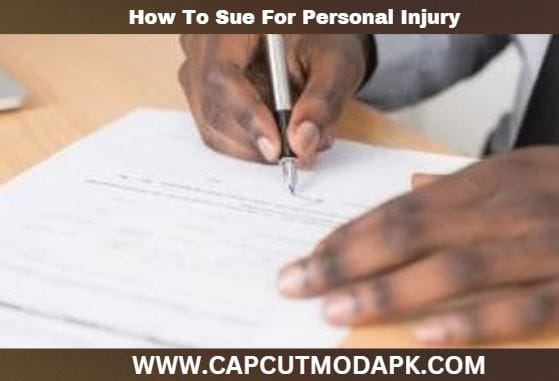If you’ve been injured due to someone else’s negligence or intentional actions, it can be difficult to know where to begin.
Personal injury cases can often seem overwhelming, especially when dealing with the emotional and physical effects of an injury.
However, it’s crucial to understand that you may be entitled to compensation for your suffering. Learning how to sue for personal injury can help ensure you receive the justice and compensation you deserve.
This post will walk you through the detailed process of filing a personal injury lawsuit, explain what compensation you may be entitled to, and offer advice on how to navigate the often complex claims process.
Also, Read
How to File a Personal Injury Claim
How To Get Compensation For An Injury
How To Find The Best Personal Injury Lawyer
What is a Personal Injury Lawsuit?
A personal injury lawsuit occurs when an individual (the plaintiff) files a claim against another party (the defendant) for injuries sustained due to the defendant’s negligence, recklessness, or intentional actions.
Personal injury law covers a broad range of accidents, including those that occur in car accidents, medical malpractice cases, slip and fall accidents, defective products, and workplace injuries.
If you are the victim of such an event, you have the right to seek compensation for the pain and suffering, medical costs, and other damages you have incurred as a result of the injury.
The process of suing for personal injury is typically handled by an attorney who specializes in personal injury law. Personal injury lawyers can help you navigate the legal system and ensure you are compensated fairly for your injuries.
Sue for Personal Injury
Filing a personal injury lawsuit is a multi-step process that can be both emotionally and mentally taxing, but knowing the steps can help you feel more prepared. Below is a step-by-step guide to suing for personal injury.
1. Seek Immediate Medical Attention
Regardless of how severe your injuries may seem, the first step in any personal injury case is to seek medical attention immediately. This step is essential not only for your health but also for building a strong case. Even if you don’t feel significant pain or discomfort at the time, some injuries (such as whiplash, internal bleeding, or head trauma) may not show symptoms right away.
Receiving prompt medical care also creates an official record of your injuries, which will play a vital role in proving your case. Without proper medical documentation, it will be difficult to demonstrate the extent of your injuries, and your case could suffer as a result.
2. Consult with a Personal Injury Lawyer
After receiving medical treatment, the next step is to consult with a personal injury lawyer. This is one of the most important steps you’ll take in the process. A personal injury lawyer will assess the details of your case and explain your legal options. Many personal injury lawyers offer free consultations, so there is little risk in speaking with a few to find someone who understands your situation and whom you feel comfortable with.
Personal injury lawyers work on a contingency fee basis, meaning they don’t get paid unless you win your case. This allows you to focus on your recovery without worrying about the upfront cost of hiring an attorney.
3. Investigate and Gather Evidence
Building a strong case requires solid evidence. Your lawyer will help you collect and review relevant documents, such as:
- Accident reports (police reports or incident reports from the scene)
- Medical records (diagnostic tests, doctor’s visits, hospital stays, etc.)
- Witness statements (people who saw the accident or incident)
- Photos (pictures of the accident scene, injuries, or damaged property)
- Correspondence (letters or emails from insurance companies, employers, or the defendant)
The more evidence you have, the better your chances of proving your case. The strength of your evidence will determine whether the defendant settles out of court or if the case goes to trial.
4. File a Personal Injury Complaint
Once your lawyer has gathered enough evidence and reviewed your case, the next step is to file a personal injury complaint, also called a “petition” or “complaint.” This document outlines the facts of your case, the legal basis for your claim, and the specific compensation you are seeking.
The defendant is then served with a copy of the complaint, and they are given the opportunity to respond. The complaint also marks the formal start of your lawsuit.
5. Engage in the Discovery Process
After the complaint is filed, both parties enter the discovery phase. During discovery, each side has the opportunity to gather information from the other party. This process can include:
- Interrogatories: Written questions that each party answers under oath.
- Depositions: Sworn testimonies from witnesses or experts who may have relevant information.
- Requests for documents: Any relevant documents, such as medical records or financial documents, that help prove the case.
The discovery phase is crucial in building a solid case and clarifying the facts surrounding the incident. This process can last several months depending on the complexity of the case.
6. Settlement Negotiations
In many personal injury cases, both sides attempt to settle before going to trial. The insurance company or the defendant may make an offer, or your lawyer may propose a settlement. This is often done through negotiation, where both parties discuss the amount of compensation that seems fair.
Settling out of court can save both time and money. However, it’s important not to accept the first settlement offer unless it adequately covers your medical expenses, lost wages, pain and suffering, and other damages. Your lawyer will help you determine whether a settlement offer is fair and whether it’s in your best interest to accept it.
7. Trial (If Necessary)
If a settlement cannot be reached, your case may go to trial. Trials can be lengthy and expensive, and there is always a risk involved since the outcome is in the hands of the judge or jury. During a trial, both sides present evidence, and witnesses testify in front of the court.
At trial, the judge or jury will decide whether the defendant is liable for your injuries and how much compensation you should receive. If the verdict is in your favor, you will be awarded compensation for your losses.
8. Appeal (If Necessary)
In the event that either party is unsatisfied with the outcome of the trial, there may be an opportunity to file an appeal. Appeals are typically based on legal errors that occurred during the trial, and the appeal is heard by a higher court. The appeals process can take several months or even years, depending on the case.
How Much Compensation Do You Get for a Personal Injury Claim?

The amount of compensation you may receive depends on several factors, including the severity of your injuries, the financial impact of the injury, and the jurisdiction where the case is filed. Compensation typically falls into the following categories:
1. Economic Damages
These are tangible losses that can be quantified, such as:
- Medical bills: Hospital stays, surgeries, doctor visits, rehabilitation, and any future medical care.
- Lost wages: Compensation for income lost while you were unable to work during your recovery period.
- Property damage: Compensation for any damage to personal property (such as a car in a car accident).
2. Non-Economic Damages
These damages account for subjective losses, such as:
- Pain and suffering: Compensation for the physical pain and emotional distress caused by the injury.
- Loss of quality of life: If your injury impacts your ability to engage in regular activities or hobbies, you may be entitled to compensation for this loss.
- Emotional distress: If the injury leads to anxiety, depression, or other psychological issues, you may receive compensation.
3. Punitive Damages
In rare cases, a court may award punitive damages if the defendant’s conduct was egregiously reckless or intentional. These damages are meant to punish the defendant and deter others from similar actions.
How Much Do Most Personal Injury Cases Settle For?
The settlement amount in a personal injury case can vary widely. Most cases settle for an amount that is based on medical bills, lost wages, and the severity of the injury. The average personal injury settlement can range from a few thousand dollars to hundreds of thousands of dollars.
For instance, in a simple car accident case, you may receive compensation for your medical bills, vehicle repairs, and lost wages, amounting to $5,000 to $50,000. In more severe cases, such as those involving permanent disabilities, settlements may range from $100,000 to several million dollars.
Settlements depend on the specific facts of the case, including the extent of the injuries and the degree of fault assigned to each party.
What is the Best Way to Make a Personal Injury Claim?
The best way to make a personal injury claim is to:
- Seek Medical Treatment: Always visit a doctor after an injury, even if you think it’s minor.
- Consult with a Lawyer: Personal injury lawyers work on contingency and can guide you through the complex legal process.
- Gather Evidence: Document everything related to the injury, including photos, medical records, and witness statements.
- Negotiate a Settlement: Most personal injury cases settle out of court. Work with your lawyer to ensure the settlement offer is fair.
- Consider Filing a Lawsuit: If negotiations fail, your lawyer will file a lawsuit and represent you through the trial process.
What Injuries Are Hard to Prove?
Certain types of injuries are more difficult to prove, especially when there is a lack of clear physical evidence. These injuries include:
- Soft Tissue Injuries: Injuries like sprains, strains, or whiplash may be difficult to demonstrate, particularly when no obvious damage is visible.
- Psychological Injuries: Emotional trauma, depression, and anxiety are challenging to prove because they rely heavily on subjective experiences and are often invisible to others.
- Chronic Pain: Ongoing pain that doesn’t show visible symptoms can be hard to substantiate, as it’s difficult to quantify the degree of suffering.
What Are the 3 Types of Injury?
Injury claims can be categorized into three primary types:
- Physical Injuries: These are injuries to the body, such as broken bones, burns, or traumatic brain injuries.
- Psychological Injuries: Emotional distress or psychological trauma resulting from the incident, like PTSD or depression.
- Financial Injuries: The financial impact of the injury, including medical expenses, lost wages, and future financial losses.
How Do Personal Injury Claims Work?
Personal injury claims begin when the injured party seeks medical treatment, consults a lawyer, and gathers evidence to support the case. The lawyer files a complaint, and both parties go through discovery. The case may settle out of court or proceed to trial, where a judge or jury determines fault and compensation.
How Long Do Most Personal Injury Claims Take?
Most personal injury claims take between 6 months to 2 years to resolve, depending on the complexity of the case and whether it settles before trial. Simple cases often resolve quickly, while complex cases that involve extensive evidence may take longer.
How Is Compensation Calculated for Pain and Suffering?
Compensation for pain and suffering is often calculated using a multiplier method, where medical bills and lost wages are added up, and a multiplier is applied based on the severity of the injury. The multiplier ranges from 1.5 to 5, with more serious injuries resulting in a higher multiplier.
Conclusion
Suing for personal injury is a detailed and multi-step process that requires careful attention to detail and professional legal representation.
By understanding the steps involved, what compensation you may be entitled to, and how the claims process works, you can better navigate the journey toward receiving the compensation you deserve.
If you’ve been injured, don’t hesitate to consult with a qualified personal injury lawyer to help you achieve the best possible outcome.



One thought on “How To Sue For Personal Injury”